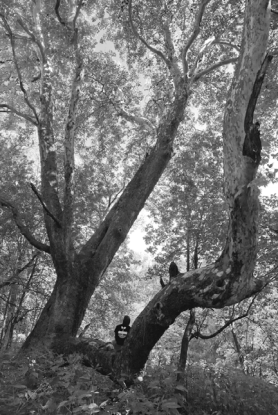Ghost Wood
Ghost Wood was originally published in the BFEC Newsletter, Vol. 14/No. 4, Fall 2010.
 In summer, hints of cream and tawny brown peek through broad green leaves. Beneath the canopy, warm light and webs of complex shadows. February. Deep in the long gray. When light forces its way through a sky of old blankets, cracked ivory spires emerge from a forest cold and drab. Where snow covers a landscape in undignified slumber, earth and sky are tied together by these white giants that define the courses of river and stream. Finches hang upside down from orb-like, yellow pods like ornaments left from the New Year, drawing life from one of the very few places left to offer it.
In summer, hints of cream and tawny brown peek through broad green leaves. Beneath the canopy, warm light and webs of complex shadows. February. Deep in the long gray. When light forces its way through a sky of old blankets, cracked ivory spires emerge from a forest cold and drab. Where snow covers a landscape in undignified slumber, earth and sky are tied together by these white giants that define the courses of river and stream. Finches hang upside down from orb-like, yellow pods like ornaments left from the New Year, drawing life from one of the very few places left to offer it.
Finally, spring buds burst from branch and twig as North America’s largest native broadleaf wakes once again. The American sycamore. Anyone who has strolled along the Kokosing has no doubt noticed one or two of its great kind.
Also known as "ghostwood" or "the button ball tree," the sycamore comes from an ancient lineage of hardwoods and is considered the most massive tree in the eastern U.S. It is estimated that a sycamore tree can attain ages of five-to-six-hundred years and is capable of growing to over eighty feet tall and sixty feet wide with a trunk circumference exceeding 40 feet.
The record American sycamore tree grows not 40 miles from Gambier in Jeromesville, Ohio. At approximately 129 feet tall, 105 feet wide and just shy of 50 feet in circumference, it is truly a paragon among its abundant Ohio kin.
While rare today, during colonization trees of this size were not uncommon. Stories even exist of humans using their often hollow trunks for storage or even long-term shelter! While the tree pictured here (courtesy of Ray Heithaus) is not large enough to keep you dry, it is awe inspiring. See for yourself on the BFEC river trail.